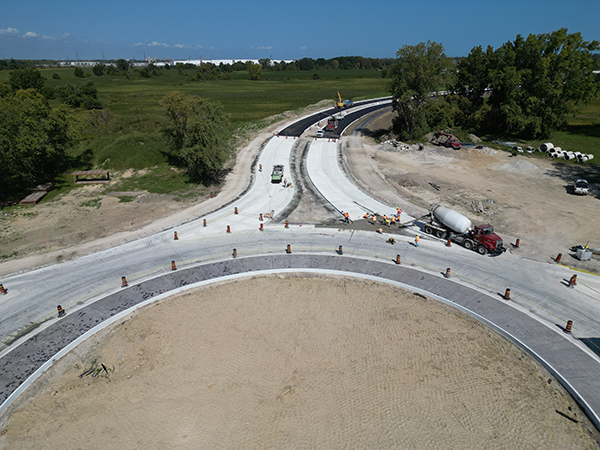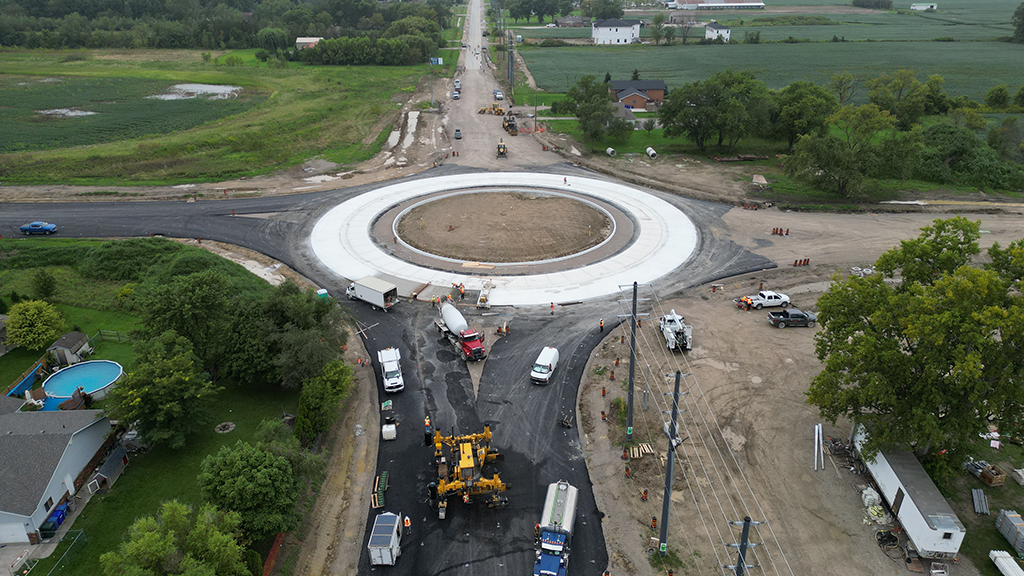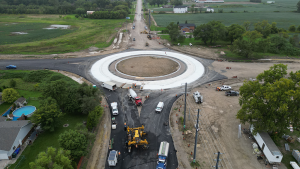Two new oversized roundabouts, unique in Ontario, are being constructed in the Windsor suburb Tecumseh to accommodate an expected flood of truck traffic primarily for the new massive NextStar Energy EV battery plant, a joint investment of Stellantis and LG.
One has just been completed and in fact won the Municipal Concrete Award from the Ontario Good Roads Association.
Good Roads’ James Smith praised the “high standard of workmanship, esthetics and innovation” and “setting a high standard” for meeting specs and deadlines.
That roundabout is at the intersection of north-south Essex Rd. 43 and east-west Rd. 42, completed last November.
The second, at roads 42 and 19, gets underway in May and will be completed by August. No specific costs were disclosed as they are part of wider infrastructure budgets.

Daniel Baggio, project manager with the County of Essex, called the corridor “heavily industrial” and will see as many as 1,000 trucks a day.
The EV plant is scheduled to be in full production later this year. A new regional hospital will also occupy the corridor when opened in 2031. Both projects are spinning off related industrial and residential growth on Windsor’s far east side. There will also be a future connection to the cross-city E.C. Row Expressway.
The second roundabout, five kilometres east, already has an interchange at Hwy. 401. Meanwhile, another new interchange will connect Lauzon Road, one kilometre west, to 401.
These oversized roundabouts with two lanes and a truck apron, have wider diameters. The entire radius measures 35 metres, lane widths 5.25 for the outside and 4.5 inside, the apron four and the center island 19.25 metres. They are “100 per cent” unique to the province, Baggio said.
“We wanted to design a roundabout that would accommodate those vehicles safely,” Baggio said. “At generally a higher speed as well.”
Higher speed?
Sure, a speeding truck could tip but the design wasn’t meant for “traffic calming,” he said. “So, if a vehicle is travelling at the posted speed limit there would not be a requirement to reduce speed significantly if traffic didn’t warrant it.”

But Baggio said the more likely reason the county won the award is that “it’s completely made out of concrete.”
This is because of southwestern Ontario’s unique climate, at least for Canada, and to build resiliency. The region has significant freeze-thaw cycles.
By contrast “anywhere north of London once it gets cold it generally stays cold for months on end,” Baggio said.
Another factor is “zero maintenance.”
The county doesn’t have a parks department so the centre ring is artificial turf. As well the lanes are made of concrete panels for easy removal, repair and replacement while keeping traffic moving in the other lane.
But full use of concrete is rare especially at this scale.
Consequently, construction methods “are a little bit unique,” he said.
A concrete paver isn’t necessarily meant for circular work.
“So, it’s just a little bit more challenging.”
There’s nothing special about the mix itself.
“It’s just an OPS specified concrete. It wasn’t anything unique.”
And the apron or rollover is a stamped brick finish.
Technically the build is 220 millimetres of reinforced concrete on top of 10 millimetres OGDL atop 150 millimetres Granular A, atop 480 millimetres Granular B, and the subbase. reinforcement is by epoxy coated dowel and epoxy tie bars.
Gianmarco Giglio, regional director of Green Infrastructure Partners (GIP), awarded the roundabouts and adjacent road work, said the road paver they wanted to use wasn’t necessarily designed for that turning radius; they borrowed a paver from another company division.
Otherwise “we poured the circle in one shot,” he said, one lane per day.
“Because we were able to do those consecutively without having to stop or break up the boys in a day because of staging if we had had to maintain traffic, it worked out a lot better.”
The roundabout was actually constructed 150 metres west of Rd. 43 due to expropriation issues so a brand new four lane, one-kilometre S-shaped diversion road was also constructed.
GIP is vertically integrated and uses few subs. So, it did the paving, sewers and mains, excavation and granular placing, electrical ducts and light poles. About a third of its 250 local staff “got their hands on that project,” Giglio said.
He added: “That’s one of the reasons we like that kind of a project because it’s got a little bit of everything.”
GIP acquired former Coco Paving in 2022.





Recent Comments